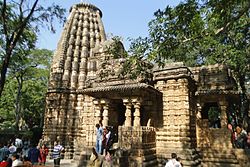11th century Bhoramdeo temple Kawardha, Chhattisgarh - 110
The Bhoramdeo temple, like others, has a square plan. The temple illustrates the Nagara-style of Hindu temple architecture. It was built in the 11th-century. It is significantly more intricately carved outside and inside the temple. Layers of festive scenes rise from ground along its shikara (spire). These scenes depict artha, kama, dharma and moksha scenes.
The temple is famous for about 50 panels of kama maithuna scenes (mithuna, eroticism and sex celebration) where amorous couples are shown in different stages of pursuit, intimacy and sexual union. Some panels include more than two participating in the sexual act. Many positions described in the kamasutra are depicted on the panel of the Bhoramdeo temple. It is also called the Khajuraho of Chhattisgarh, though it is a bit older than the Khajuraho temples.
The Bhoramdeo temple faces east like most Hindu temples. It is next to a lake. It has three sheltered and pillared entrances (east, north, south). These lead to a mandapa (hall), then an antral (passage) to the garbhagriya (sanctum). Both the mandapa and the sanctum are square. The sanctum is below the mandapa level, a feature found in some other Shaiva temples in this region. It has Shiva linga.
The temple reverentially includes different avatars of Vishnu and of Shakti (Devi). Many other Vedic deities as well as post-Vedic deities such as Ganesha are prominently exhibited in the reliefs. Examples include Uma-Maheswar, Nataraja, Narasimha, Vamana, Krishna, Surya , Bhairava, Kartikeya, Shivaganga, Chamunda, Ambika, Sapta-Matrika and Laxmi-Naryana.
A layer of relief wraps the lower end of the temple, featuring alternate elephants and lions. Above these are scenes of everyday life and people of different ages. Economic activity, festivals, sex, arts, dance, music and other themes are all celebrated in different layers and sections.
Inside the temple, reliefs and carvings show scenes of the Ramayana and Mahabharata.
Next to the Bhoramdeo temple are older temples, also dedicated to Shiva. One is a brick structure temple, also with intricate carvings. In the sanctum, the king and queen are seated in prayer before a Shiva linga.Relevante Bilder
Relevante Artikel
KawardhaKawardha ist eine Stadt (Municipal Council) mit etwa 60.000 Einwohnern im Nordwesten des indischen Bundesstaats Chhattisgarh; sie ist der Hauptort des Distrikts Kabirdham. .. weiterlesen












